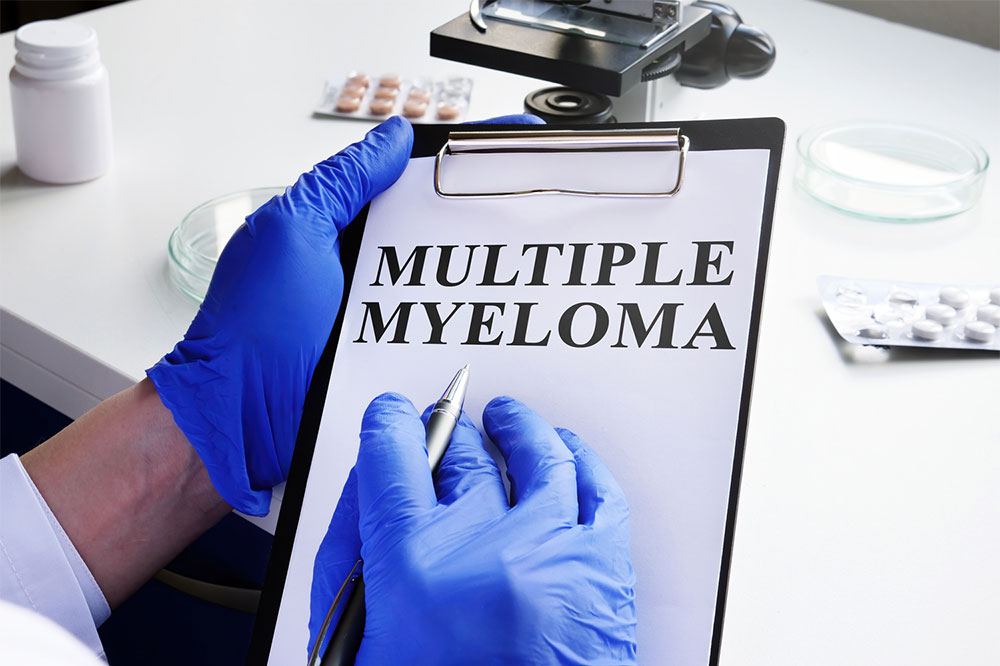
8 common symptoms of multiple myeloma
Multiple myeloma is the cancer of plasma cells—a type of white blood cell. These cells, when healthy, help combat infections by creating antibodies. However, this disease can cause cancerous cells to accumulate in the bone marrow, overpowering the healthy blood cells. Over time, the abnormal cells begin to produce abnormal proteins that can damage the organs. People can experience a range of mild to severe multiple myeloma symptoms that begin to appear as cancer spreads.
Bone pain
This is one of the most common multiple myeloma symptoms. The condition causes myeloma cells to develop in the cortical bone and bone marrow. This results in bone thinning and damage or osteoporosis, making the bone susceptible to breakage. The ribs and the back are the most common pain areas; however, any bone may be affected. People with multiple myeloma usually experience maximum pain during nighttime.
Fractures
The disease weakens the bones, making them susceptible to fracture or breakage. Usually, the long bones in the arms and legs or the spine are affected. In some people, the spine fractures cause sections of the spine to collapse, resulting in pain and even spinal cord compression. The compression can induce weakness and numbness in the legs and feet, pins and needles sensation, and bowel and bladder control issues.
Fatigue
Fatigue is the lack of stamina or overall feeling of tiredness and is not the same as feeling sleepy or drowsy. When fatigued, people have no energy or motivation. In healthy bodies, white blood cells can fight and get rid of germs with relative ease. However, multiple myeloma can make the body work harder as there are fewer disease-fighting cells. This can make people feel exhausted quickly.
Kidney damage or failure
Multiple myeloma can lead to an increase in the production of M protein, which can disrupt the kidneys’ functioning by hindering the process of filtering out toxins. In its early stages, kidney damage may not exhibit any symptoms, and so it is diagnosed solely through urine and blood tests. When the condition worsens and causes kidney failure, people can experience symptoms like fatigue, weakness, itching, muscle cramps, appetite loss, nausea, changes in urination patterns, swelling (in the ankles, feet, or legs), anemia, trouble sleeping, and shortness of breath.
High calcium levels (hypercalcemia)
Excessive calcium in the blood is also one of the common multiple myeloma symptoms. The breakdown and thinning of bones can increase the amount of calcium in the blood. Some signs of hypercalcemia signs are feeling sick, extreme thirst, constipation, frequent urge to urinate, stomach pain, drowsiness, and confusion. These can be warning signs that should be communicated to the doctor.
Anemia
This is a common multiple myeloma symptom as abnormal cells crowd the healthy blood cells, resulting in reduced white blood cells (leukopenia) and red blood cells (anemia). The low count makes it hard for the body to combat infections. Anemia can make people look pale and feel extremely tired, dizzy, and irritable. It can also increase the risk of heart issues and contribute to lower platelet levels, making it harder for the blood to clot.
Unusual bleeding
The disease can result in unusual bleeding (hemorrhage) and bruising in some people. Hemorrhage is a multiple myeloma symptom that usually develops during the clinical course in approximately 15% of patients. People may also experience heavy periods, bleeding gums, and frequent nosebleeds. The cancer cells in the bone marrow can block platelet development, leading to hemorrhage.
Thickened blood
In some patients, blood can become thicker due to elevated plasma immunoglobulin levels brought on by excessive protein production. This multiple myeloma symptom is called hyperviscosity syndrome (HVS) and can induce symptoms like headaches, blurred or cloudy vision, bleeding from the nose or gums, dizziness, and shortness of breath.
What causes multiple myeloma?
While the exact cause is not known, experts believe that the condition stems from changes in the genes responsible for the plasma cell division and growth. The American Cancer Society indicates that the most prevalent genetic mutations are:
Deletion of parts of chromosome number 17
Changes in the tumor suppressor genes like p53 genes
Abnormalities in oncogenes such as MYC and RAS
Additionally, abnormalities in dendritic cells (found in the bone marrow) can also result in multiple myeloma. These cells release a hormone called interleukin-6 (IL-6), which in excessive amounts can trigger excess plasma cell growth.
Persistent concerns should be communicated to a healthcare professional. When multiple myeloma symptoms are detected, the doctor will ask you to speak with either a hematologist specializing in treating bone marrow and blood disorders or an oncologist.




